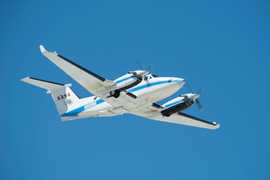The Side-Looking Airborne Radar (SLAR) is an airborne imaging system that points perpendicular to the flight direction. SLAR sends a beam of energy to the surface perpendicular to the flight path and detects the return signals to create radar images of the terrain. It usually operates in the X-band (8-12 GHz). SLAR can gather imagery regardless of weather or time of day and has been used for mapping geological features and cloud-covered regions because of its ability to penetrate clouds.

Instrument Details
- Radar
- Earth Science > Spectral/engineering > Radar > Radar ImageryEarth Science > Spectral/engineering > RadarEarth Science > Spectral/engineering > Radar > Radar Backscatter
- Land Surface
- Variable
- Variable
- 8-12 GHz
- Currently unavailble
Currently unavailable
Currently unavailable
Currently unavailable
Currently unavailable
Currently unavailable
Unpublished
 Beechcraft B-200 King Air 38 Campaigns · 84 Instruments |  First International Satellite Land Surface Climatology Project (ISLSCP) Field Experiment 1987—1989 Central Kansas 2 Deployments · 115 Data Products
|